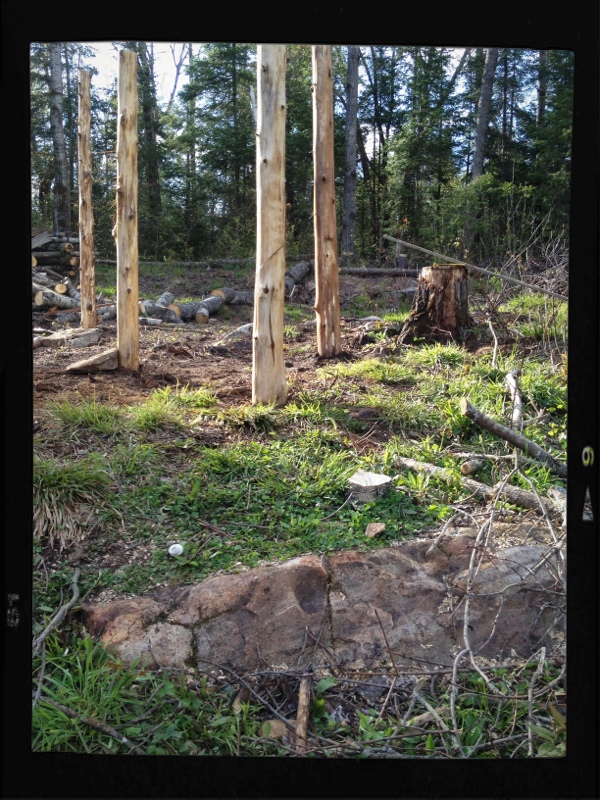You may recall a March post where we scored some cedar posts which were unsuitable for proper fencing.
Fortunately, 'proper' is a relative term, and fencing they shall become.
Despite their size, the cedar posts are glorious to work with.
They are dry and well seasoned. The bark is just falling off, so it really takes less than a minute to strip them.
Normally, fence posts would be eight inches or so. These posts are six and under.
It makes little difference.
The soil is shallow, so they will never be planted well enough to need the additional diameter.

I have been planning the fence lines for months.
All I needed was to run an actual rope to lay the fence line out.
This helps keep the fence line straight and on track.
Unfortunately, the ground won't always let you place a post where you would like it to go, so the line meanders somewhat.
There was also the matter of the property line again.
This fence will run the border, so it was time to check the numbers and get the compass out.
It's as close as I can get it.
It may not be accurate enough for the suburbs, but out here, a few inches out won't be a problem.
So what do you think I dig post holes with?
A post hole auger?
It's actually an ice auger for fishing, but it does double duty well.
Of course, there can't be any roots, or rocks in the ground or the auger is useless.
It worked for a few holes, but I soon gave up on it.
There are special shovels for this job, but I don't own one.
Besides, I don't think it would work anyways.
Above is my new spade.
The last one died a bitter and spiteful death in my hands.
This land is unforgiving.
The new shovel is a heavy duty tool.
Of course, the spade doesn't really work in the bad spots anyways.
Kira's good trowel came out to work with the serious equipment.
As hateful as it is digging post holes with a trowel, as least it worked.
The smaller blade finds it's way through the smaller stones.
It also allows me to customize the hole to the post.

Without an axe, this job would be impossible.
This area was forest only recently.
The ground is full of roots, large and small.
The wild beating of the sharpened wedge makes short work of pesky roots.
That's funny. 'Pesky' is not the word I would choose while chopping roots.
The sledgehammer?
I just use that when nothing else works.
It usually doesn't either, but it's a wonderful stress reliever.
Because of the shallow post holes, the posts will need bracing here and there.
The corners are usually braced anyways, but in some places, the braces will get elaborate.
This is my first time doing this kind of fencing, but the existing electric fencing was built strong enough to hold on to the heavy stuff I'm using for this job.
Some places have only a few inches of topsoil before there is bedrock.
To build a corner, there needs to be at least three posts with braces top and bottom.
This time, I'll install the fence and then hunt for weaknesses afterwards.
I don't have the time to overbuild unnecessarily.
When the mark falls on a stump, we break out the axe and start beating the .... out of it.
The bonus is that stumps usually cling to a large number of rocks.
It's not unlike an octopus clinging to all of it's worldly possessions.
I have a 'no stump removal' policy in place.
They will rot in time.
I often wonder what the contour of the bedrock is like.
There are times when I am surprised at the depth of soil.
The bedrock rises out of the ground, only to plunge back down again a few feet over.
There are remarkable pockets of deep quality soil in places.
The only way to distinguish soil depth is to dig a hole.
There may be a difference of more than twelve inches within only several feet.
The deep soil is still filled with rocks, but unlike the bedrock, they are removable.
This fence will keep the chickens confined to a yard that they may call their own.
In order for us to have ground fruit, seedlings, and colourful vegetables, we must either fence the plants or fence the chickens.
They will still have a lot of land to roam, but they won't have unlimited access anymore.
Within the compound, there are already apple trees.
There is space for more fruit bearing trees in with the chickens.
The chickens will glean pests and help protect the trees, while the trees will give the chickens shade and the inevitable treats that will fall before we pick them.
This fence will make significant changes to what we will be able to do, and how we lay out the gardens and fruit.
Mixing chickens and fruit trees will be repeated elsewhere if it works out.
It may seem simple enough for farm infrastructure, but the implications are exciting and far reaching.









No comments:
Post a Comment